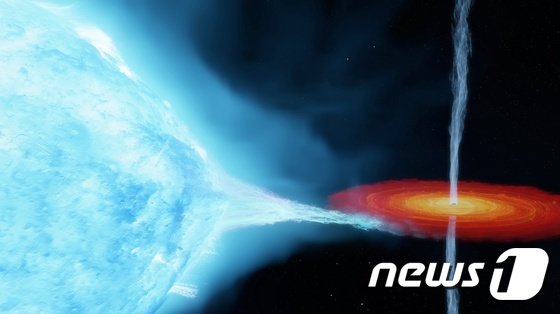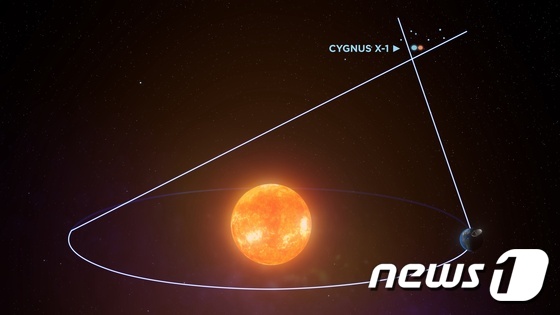 |
| Location and trigonometric parallax distance measurement method of X-1 Cygnus © International Center for Radio Astronomy Research (ICRAR) /News1 |
The first black hole discovered, the X-1 Cygnus black hole, was found to be farther from Earth and heavier than was originally known.
International joint research teams including the Korea Astronomical Research Institute measured the precise location of the X-1 Cygnus black hole with a very long baseline radio interferometer (VLBA) connected to 10 radio telescopes.
As a result, it was revealed on the 19th that the black hole X-1 Cygnus was found to be a farther and heavier black hole than previously known.
X-1 Cygnus is a binary star system with a black hole and a blue supergiant star.
It was first discovered in 1964 through an X-ray detector mounted on a high-rise atmospheric observation rocket.
The material entering the black hole with strong gravity from the companion star rotates rapidly, emitting a fast jet close to the speed of light and powerful X-rays.
The international joint research team drew the results of this study through a triangulation method that precisely measures the location of a celestial body at a distance from the Earth by observing the radio signal from the black hole X-1 Cygnus using an ultra-long term radio interferometer (VLBA).
Accordingly, it was found that the distance from Earth to the black hole X-1 Cygnus is about 7200 light-years farther than the previously known about 6100 light-years, and the mass of the black hole is 21 times the mass of the Sun, which is about 50% heavier than the known mass.
 |
| . X-1 Cygnus Binary System Imagination © International Radio Astronomy Research Center (ICRAR) / News |
Professor James Miller-Jones of Curtin University, Australia, who led the study, said, “Through this observation, we have found that the X-1 Cygnus black hole is farther away than the previous hypothesis and is a heavier black hole.” It will be the evidence to newly reveal the process of formation and growth until now.”
In addition, co-author of this paper, Professor Ilya Mandel of Monash University in Australia, said, “As a result of this study, the X-1 Cygnus black hole was a star with much heavier mass than the previous hypothesis.” This means that the losses were relatively small. “The black hole X-1 Cygnus may have been formed tens of thousands of years ago when a massive star, about 60 times the mass of the Sun, collapsed by gravity.
Dr. Tae-Hyun Jeong of Korea Astronomical Research Institute said, “In this study, Cheonmun-yeon contributed to the design of a precise positioning method for the black hole in the constellation Cygnus using a radio interferometer.” “We will continue to study black hole observations such as X-3 Cygnus using a radio wave observation network (KVN, Korean VLBI Network).”
Meanwhile, the results of this study were published in the internationally renowned academic journal’Science’ on February 18, 2021.
